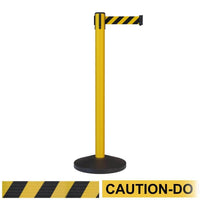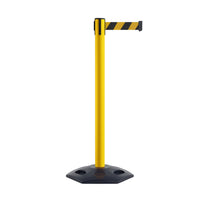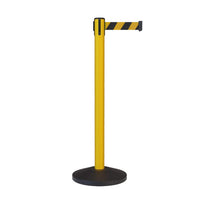Safety Belt Barrier Stanchions
Safety Belt Barrier Stanchions Features & Benefits
Stanchions of any kind contribute to workplace safety simply by keeping crowds organized, but our safety stanchions are especially optimized for this with high-visibility colors, sturdy frames, and long belt lengths intended for industrial environments where workplace caution is needed. Stanchions like these may also be helpful for workplace safety plans, OSHA requirements, and general hazard control.
Here are some of the specific features which make safety stanchions useful in hazardous work zones:
- Safety stanchions use high-visibility colors like yellow, orange and red.
- Safety stanchions can include safety messaging along the retractable belt.
- Safety stanchions are available with sturdy, weather-proof posts and cases for the retractable belt canister.
- Safety stanchions are also available with durable, rubber bases which can endure some tire tread.
- Safety stanchions are available with extra long belts to accommodate industrial environments.
Frequently Asked Questions: Safety Stanchions
Q: Can the belt end attach to a surface other than another stanchion, like a wall?
A: Wall mount receivers can be purchased so that a safety stanchion's belt end can clip into place along a wall without requiring another stanchion.
Q: Are safety stanchions suitable for outdoor use?
A: Standard safety stanchions can withstand some, limited outdoor use, but specific outdoor types are advised for extended outdoor use. Look, for instance, for the safety stanchions with rubber bases, as these are more suitable for extended outdoor conditions.
Q: How does the belt breaking system work?
A: The belt breaking system is an internal design to help slow the retraction of the belt to a safe and reasonable speed. This will function automatically upon retraction and you do not need to operate that system.
Q: Could this belt extend at an angle?
A: When extending the belt, you'll want to pull the belt straight outward, but it can be clipped into a wall at an angle.
What The Color Yellow Says About Risk

Most of us recognize that bright yellow means extra caution is required. But where does this association come from? As it turns out, yellow is the brightest of the visible colors and is therefore literally the most noticeable to our eyes. With this in mind, it’s no surprise that both the American National Standards Institute and OSHA assign special importance to the color yellow, or that our safety retractable belt barrier stanchion collection emphasizes this safety color.
ANSI advises the use of safety yellow for “Caution”. For instance, yellow should be used for the following scenarios:
-Messages about safety-wear recommendations for operating certain machinery
-Day-to-day hazards such as wet floors
-Notification of construction or employee-only zones
-Warnings for exposed ledges
-Warnings for moving equipment or other potential physical hazards
OSHA too considers yellow the appropriate color for communicating hazard warnings. Think of yellow as the universal warning of potential injury.
What Other Colors Say About Risk

Bright and noticeable as it may be, yellow is not the only warm-tone color used for cautionary messaging. ANSI suggests orange for situations where the risk potential is even higher. If yellow indicates the risk of injury, orange indicates the risk of serious injury or death.
According to Ansi, orange should be used for “Warning” type messages like the following:
-High voltage areas with electrical hazards
-Work sites, especially where exposed, moving machinery may be present
-Road construction
Red on the other hand should be used for “Danger” cautions and fire hazards, according to ANSI. For instance red might be used for the following situations:
-Fire extinguishers and alarms
-Emergency buttons, switches, and levers
-Flammable materials
Our safety retractable belt barriers accommodate each of these precautionary colors by offering red safety belt barriers or posts, orange safety belt barriers or posts, or the most common yellow safety belt barriers and posts.
When To Use Safety Stanchions

Safety stanchions with yellow belts and posts can be useful tools for workplace safety plans and, when used properly and with the guidance of an OSHA professional, an integral part of OSHA compliance. Most loading docks are 48 inches or more above the ground and therefore require sturdy, physical guards or barriers strong enough for fall protection, sustaining the weight of a person or even a forklift. However, OSHA sometimes allows visual barriers when physical barriers would significantly interrupt the flow of work, (and if the local state regulations allow). In such cases yellow retractable belt barrier safety stanchions might be useful as visual barriers. These safety stanchions should have yellow posts, and even include yellow in the belt barrier as well. They are useful for their ability to be easily extended and clipped into place or retracted again. Since many loading docks have metal frames, magnetic belt barriers may be useful as well. Regardless of your plan, make sure to consult your OSHA specialist and bear in mind these stanchions do not suffice as “fall protection”. These stanchions are instead useful for communicating caution with their high-visibility yellow cautionary colors.

Use Cases For Safety Belt Barriers

Safety Stanchion Collection Benefits
Post Types
| Stanchion Post Colors | Yellow, red, and orange, black, stainless steel, or custom. |
| Stanchion Post Materials | Steel or aluminum |
| Post Types | Indoor, outdoor, rolling, or fixed & removable.” |
Belt Types
| Colors | 30+ Color options |
| Belt Messaging | Yellow, red, and black message belts with black or white cautionary messaging. |
| Belt Width | 2" belt widths |
| Belt Lengths | 7.5, 8.5, 10, 13, 15, 20, 25, 30, or 35 foot belt lengths. |


 Belt Barriers
Belt Barriers
 Barricades
Barricades
 Classic Stanchions and Ropes
Classic Stanchions and Ropes
 Wall Mounted Belt Barriers
Wall Mounted Belt Barriers
 Plastic Stanchion Posts and Chains
Plastic Stanchion Posts and Chains
 Signage
Signage
 Traffic Control
Traffic Control
 New Products
New Products






























